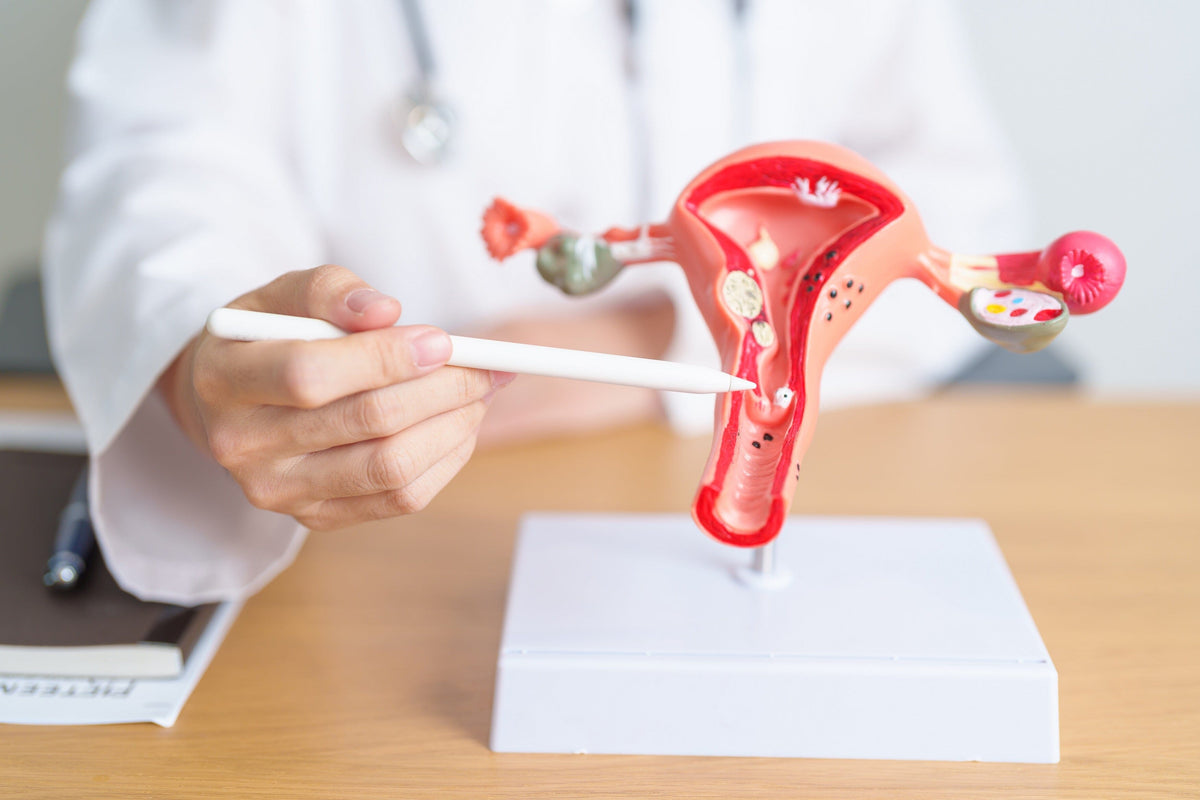Are you dealing with uterine fibroids after menopause? If so, you’re not alone. While it’s true that most uterine fibroids shrink after menopause, that’s not always the case. In some women, they can persist, continue to grow, or even start causing new symptoms.1
Let’s take a closer look at what causes uterine fibroids, why they may persist after menopause, who’s more likely to experience them, and what you can do about them.
Do Fibroids Go Away After Menopause?
Bonafide Chief Medical Officer, Dr. Alyssa Dweck, explains, “Uterine fibroids—also called leiomyomas—are benign growths that develop in or on the uterus and occasionally in other pelvic locations. Fibroids are hormonally sensitive and incredibly common during someone’s reproductive years. As menopause approaches and hormone levels decline, many fibroids naturally shrink or stop causing symptoms. While persistence or growth of fibroids can occur during menopause, this is not the norm. Rapid growth or persistence or worsening of symptoms, should prompt evaluation.”
But here’s the catch: that shrinking doesn’t happen for everyone. In fact, one study showed over 30% of new fibroid diagnoses occur in women aged 45-49, however this may be slightly inflated due to an increase in imaging with age/menopause onset2.
So, what’s going on?
What Causes Uterine Fibroids to Grow After Menopause?
Even after menopause, your body still produces small amounts of estrogen, especially in fat tissue and your adrenal glands. Functional medicine believes that for some—particularly women with higher levels of body fat or metabolic syndrome—fibroids may continue to grow or stay active.3
In other cases, fibroids may calcify, which means they harden due to decreased blood flow. While this will stop them from growing further, it doesn’t always relieve symptoms, especially if the fibroids are already large or pressing on nearby organs.4
But rest assured, this kind of postmenopausal fibroid growth isn’t necessarily dangerous. While the uterus typically shrinks after menopause, smaller fibroids may continue to grow; symptoms—rather than size—determine whether treatment is necessary – with the exception of fibroids that are growing rapidly, which should be evaluated.5
Dr. Dweck summarizes it this way: “Fibroids typically do not develop de novo during menopause, but those that were present during reproductive years, may persist. They often calcify and/or shrink over time with diminishing hormone exposure. If fibroids multiply, grow rapidly, or are associated with symptoms such as pain, pressure, bloating, or bleeding, prompt evaluation is in order.”
Who’s Most at Risk for Uterine Fibroids?
One of the first questions many women with uterine fibroids may ask is: Why me?
While the exact causes of fibroids remain unclear, functional medicine research has uncovered several factors that can increase risk, especially for persistent or postmenopausal fibroids:6
- Race and ethnicity (fibroids are more common and often more severe in Black women)
- Family history of fibroids
- Increased body fat or high cholesterol
- Low vitamin D levels
- Chronic inflammation or stress
Fibroids contain estrogen and progesterone receptors, which means they’re highly responsive to hormonal shifts. This may help explain why some women are especially sensitive to hormonal fluctuations—even long after menopause.7
What Are the Symptoms of Uterine Fibroids?
Fibroids are sneaky. About half cause no symptoms at all—but others may lead to: 8,9
- Heavy or irregular bleeding, even after menopause
- Pelvic pain or pressure
- A feeling of fullness in the abdomen
- Pain during sex
- Frequent urination
- Back or leg pain
- Anemia due to blood loss
If fibroids are growing after menopause, your healthcare provider may want to rule out rare conditions, including uterine cancer. Although most fibroids are benign, you should receive a checkup if you experience any new bleeding or enlargement of existing fibroids.10
According to Dr. Dweck, “Bleeding after menopause is not normal and warrants evaluation. Fibroids do not typically cause bleeding during menopause, even though during the reproductive years, fibroids can cause heavy menses. Fibroids can cause pain and pressure, but sudden or new onset of discomfort during menopause suggests growth and thus should be evaluated promptly. A thorough medical history—including a history of, or current hormone use—a physical exam, pelvic imaging, and potential tissue sampling or other testing may be warranted.”
What Are Your Uterine Fibroid Treatment Options?
The best fibroid treatment? It depends on you.
Your symptoms, age, health history, and whether fertility is still a consideration all play a role in how you manage uterine fibroids. While menopause typically marks the end of the reproductive years, some women may still be navigating perimenopause, fertility preservation, or decisions around keeping their uterus.
That’s why it’s so important to talk with a healthcare provider who can see the full picture—not just the fibroid.
Depending on your needs, uterine fibroid treatment options may include:
Surgical treatments, such as:11
- Hysterectomy – removal of the uterus (often recommended if symptoms are severe and fertility is no longer desired)
- Myomectomy – surgical removal of fibroids, preserving the uterus, which may be appropriate for women still considering fertility or those who prefer a uterus-sparing approach
- Fibroid resection via hysteroscopy – a vaginal procedure allowing for shaving out a fibroid; only appropriate for submucous fibroids
Minimally invasive or medical options, including:12,13
- Uterine artery embolization (UAE) – cuts blood supply to shrink fibroids
- Aromatase inhibitors – help block estrogen production, especially in obese women
- Selective estrogen or progesterone receptor modulators (SERMs/SPRMs) – shrink fibroids and reduce bleeding
If you’re currently using hormone replacement therapy (HRT) for menopause, your healthcare professional may monitor fibroid size with periodic ultrasounds to ensure your fibroids are not growing.14
The Bottom Line: Speak Up
Fibroids don’t always follow the rules—and neither should your care.
Whether you’re postmenopausal or perimenopausal, your symptoms, comfort, and goals matter. That includes how your body responds to hormones, whether fertility is still being considered, and how fibroids are impacting your life.
Never ignore abnormal bleeding, pelvic pain, or fibroid symptoms after menopause. Trust your instincts. Whether you want a second opinion, imaging, or just reassurance, your concerns matter—and your comfort does, too.
Resources
- https://www.medicalnewstoday.com/articles/319576
- https://pmc.ncbi.nlm.nih.gov/articles/PMC6994343/
- https://www.ifm.org/articles/factors-predisposing-women-to-fibroids
- https://www.usafibroidcenters.com/blog/does-menopause-affect-your-risk-of-fibroids/
- https://www.mayoclinic.org/diseases-conditions/uterine-fibroids/multimedia/vid-20538086
- https://www.ifm.org/articles/factors-predisposing-women-to-fibroids
- https://www.ama-assn.org/delivering-care/population-care/what-doctors-wish-patients-knew-about-uterine-fibroids
- https://www.medicalnewstoday.com/articles/319576
- https://pmc.ncbi.nlm.nih.gov/articles/PMC6994343/
- https://www.health.harvard.edu/womens-health/fibroids-not-just-a-young-womans-problem
- https://www.healthline.com/health/menopause/fibroids-after-menopause
- https://pmc.ncbi.nlm.nih.gov/articles/PMC6994343/
- https://health.clevelandclinic.org/uterine-fibroids-after-menopause
- https://pmc.ncbi.nlm.nih.gov/articles/PMC6780684/








